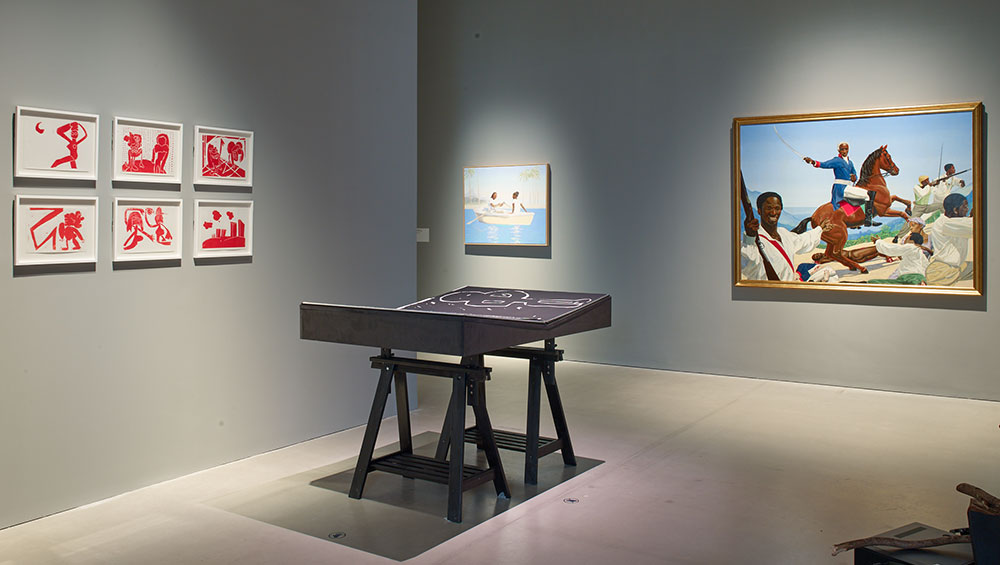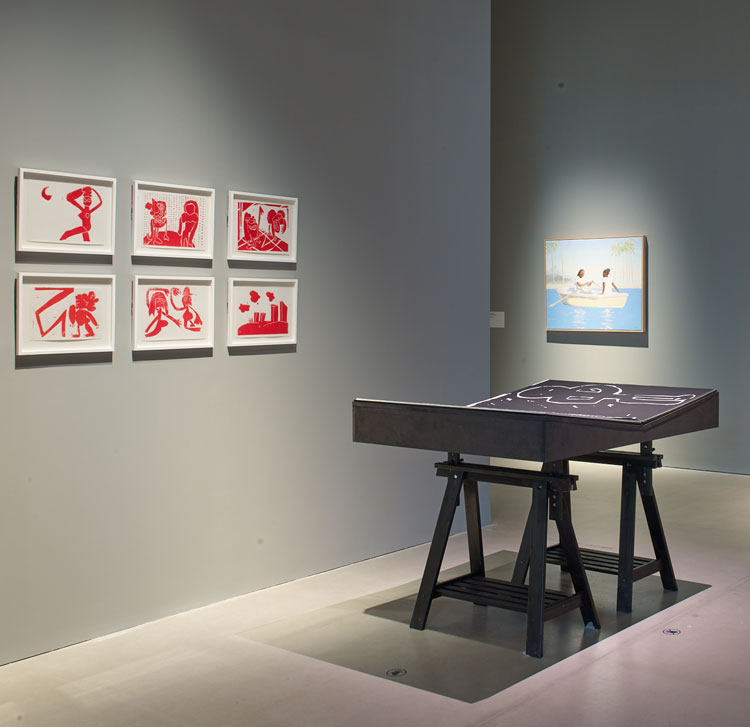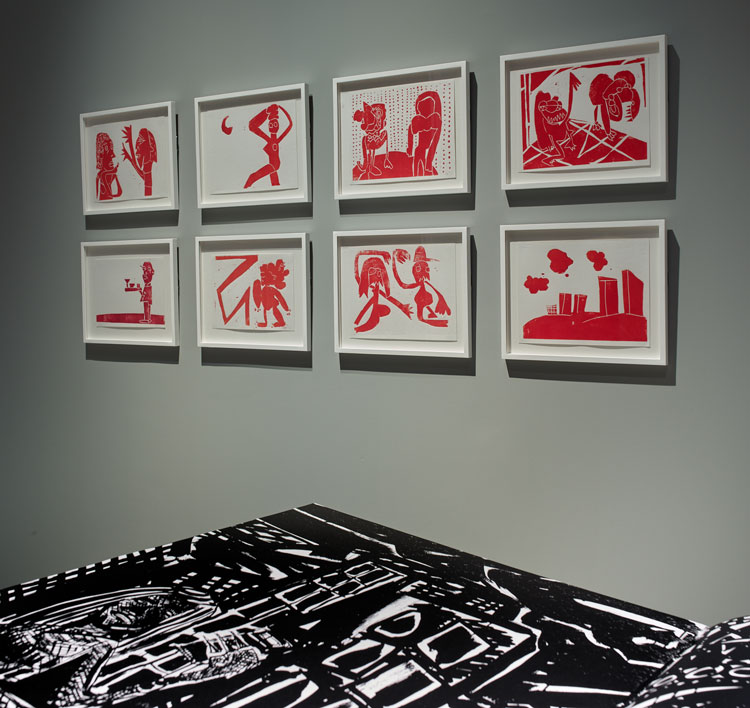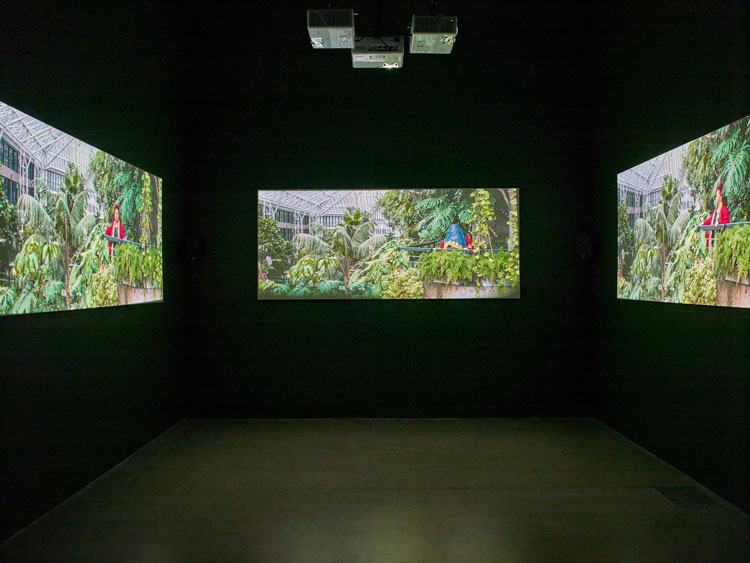
UNTITLED: Art on the conditions of our time, 2021, Kettle’s Yard, Cambridge. Photo: Stephen White.
Kettle’s Yard, Cambridge
10 July – 3 October 2021
by BETH WILLIAMSON
The cultural and political issues of our time are at the forefront of what is, frankly, one of the most thought-provoking exhibitions of British African diaspora artists I have seen in recent years. To bring 10 such artists together in a gallery like Kettle’s Yard is to concentrate the effect of the works, to focus our attention more acutely and to provide a different context, including three new works commissioned by the gallery. The exhibition’s curator, Paul Goodwin, is clear that his aim in this exhibition was to go beyond “black survey shows” and open up contexts of shared contemporary concerns.

Kimathi Donkor. Toussaint L’Ouverture at Bedourete,
2004. Oil on linen, 136 x 183 cm. Courtesy the artist.
Goodwin explains: “Instead of focusing on blackness ahead of the works themselves, Untitled flips this order and focuses on the works first and foremost. Questions of blackness, race and identity are then shown to be entangled in the multitude of concerns – aesthetic, material and political – that viewers can encounter without the curatorial voice obscuring the works.” This refocusing begins with the exhibition’s title, Untitled, and its reference to the convention in art of leaving works untitled in order to emphasise the works themselves rather than any context. Curiously, however, the exhibition’s subtitle goes on to provide a little of that context, in broad terms at least.

Larry Achiampong and David Blandy. Finding Fanon Part One, 2015. Courtesy of Copperfield Gallery & Seventeen Gallery, London. Image: Claire Barrett.
The 10 artists – Larry Achiampong & David Blandy, Barby Asante, Appau Junior Boakye-Yiadom, Phoebe Boswell, Kimathi Donkor, Evan Ifekoya, Cedar Lewisohn, Harold Offeh, Ima-Abasi Okon and NT – work in a variety of media with a range of material concerns. There is painting, drawing and printmaking, performance, sound and video. There is a lot of video work in this exhibition, perhaps a little too much to fully concentrate on and appreciate, so it is very welcome to see that works are being made available in full on the Kettle’s Yard website, especially when some require 30 to 60 minutes viewing.

Cedar Lewisohn. Untitled (Red Woodprints, Lewisham series), 2020 and Black Drawings, 2015, installation view, UNTITLED: Art on the conditions of our time, 2021, Kettle’s Yard, Cambridge. Photo: Stephen White.
Lewisohn’s works Untitled (Red Woodprints, Lewisham series) (2020) and Black Drawings (2015) immediately caught my attention. Black Drawings is almost a distillation of the entire curatorial strategy here. Lewisohn created them as part of a residency at the Jan van Eyck Academie in the Netherlands, where he explored ideas of cultural appropriation and reappropriation. It is well known that modernist artists such as Picasso appropriated African art and culture into their work. Lewisohn goes beyond this to consider how the appropriation and absorption of visual styles affects the way in which the cultures they belong to are understood. Lewisohn looked in particular at German expressionist artists such as Max Beckmann and Karl Schmidt-Rottluff, and his strategy was to extract all the visual information possible from them, leaving behind just enough material for viewers of Black Drawings to get a sense of what he was looking at when he made them. It works beautifully.

Cedar Lewisohn. Untitled (Red Woodprints, Lewisham series), 2020 and Black Drawings, 2015, installation view, UNTITLED: Art on the conditions of our time, 2021, Kettle’s Yard, Cambridge. Photo: Stephen White.
His works Untitled (Red Woodprints, Lewisham series) have rather different beginnings. They merge ancient African and Mesopotamian objects with aspects of contemporary youth culture, including knife crime. I learned that knives held in police collections are archived using the same categories as museum displays of ancient weaponry. This makes for some interesting parallels between museum collections and knife crime, just one of the themes the artist tackles further in his new publication The Marduk Prophecy. I hadn’t seen Lewishon’s work before this exhibition, but I am now fascinated, and keen to learn more.

Greta, 2021, by the artist NT, installation view, UNTITLED: Art on the conditions of our time, 2021, Kettle’s Yard, Cambridge. Photo: Stephen White.
The large-scale, immersive film installation Greta (2021), by the artist NT, is a newly commissioned film portrait of the dancer and choreographer Greta Mendez. Mendez is a performance artist, movement and theatre director, producer, choreographer, dancer and carnivalist. It is her work with dance and carnival communities in the UK, work that we are told has been neglected, that is foregrounded here. Filmed in the Barbican Centre’s less-known conservatory space and presented across three screens that fill the viewer’s field of vision, NT shows Greta engaging with the space in different ways.

Production still for NT’s Greta. Photo: Thierry Bal.
The three screens do not replicate each other, but instead show slightly different scenes as Greta moves around the brutalist architecture and unusual plants, and appears at different points and places. The experience of being immersed in this installation created a strange feeling of simultaneous distance and closeness: the distance perhaps because of the scale of the architectural space that Greta occupied and the closeness because of the effect of her carefully choreographed movements across multiple screens in a small gallery. For me, this was the outstanding work of the exhibition, the one I found my mind drifting back to later and one I want to experience again. NT has created something wonderful here.
I must also say something about Boakye-Yiadom’s new installation for this exhibition, After: Many Long Conversations (2021). Consisting of two mobile room dividers, photographic prints and a soundtrack, this work reflects on facets of performance and exchange in the House at Kettle’s Yard. The soundtrack was recorded using the two pianos in the House, and the installation in the gallery is the only space where I saw multiple visitors sit down and attend fully to the work around them. Boakye-Yiadom’s engagement with the House in this work is not made directly. Rather it is “distilled to the point of abstraction” and all the more interesting because of that.
I want to finish where I began, with the exhibition’s curator, Goodwin, who himself says it is a bold curatorial approach that he has taken, that it enables the viewers to encounter key concerns without the works being “obscured” by the curatorial voice. I was sceptical when I read these claims printed on the gallery wall. Yet after looking at each work in turn, doubling back and looking again, and later reflecting, I would say Goodwin has been pretty successful in his aims. Asante’s work in this exhibition is inspired by Audre Lorde’s essay Poetry Is Not a Luxury (1985). Goodwin’s hand in this exhibition proves that good curators are not a luxury either, especially when, as here, their aim is to quieten the curatorial voice and leave more room for the viewer to encounter the work.